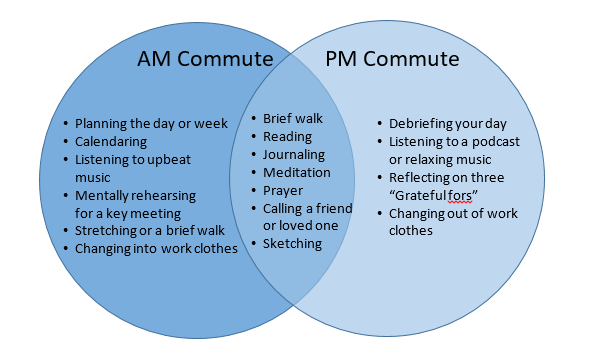Virtual Commuting: A Leadership Practice with Surprising Benefits
Editors’ Note: This is an updated version of an article published in Fast Company.
We’ve heard a thousand tips lately for working more effectively at home, but here’s a fresh, simple, and powerful daily practice with important benefits for overtaxed leaders who now work remotely or in flex work arrangements.
Shelter in place orders and the closure of huge numbers of “non-essential businesses” during the global pandemic of 2020 created a strange and disconcerting work challenge for a massive number of workers. Millions quickly set up makeshift home offices and were left grappling with the competing and overlapping demands of work and family responsibilities. In short order, the boundaries between work and home life were obliterated. Those with young children or other dependents in their care felt it most acutely, as they juggled daycare or elder care, home schooling, preparing all meals at home, myriad household tasks, and the difficulties of maintaining cordial relationships in cooped-up circumstances.
By now, this once abrupt change has become the “new normal,” with some workers permanently working from home and many others adopting a flex or hybrid schedule involving a mix of WFH days and days commuting to a work site. And yet, while we may feel most have settled into a more standard routine, sustaining this new normal is not easy. The so called Great Resignation and Quiet Quitting phenomena signal that things are not right and not sustainable for a large portion of workers.
As executive coaches and leadership assessment specialists, we and our MDA colleagues hear daily from leaders who worry about the long-term toll of this new normal. Interestingly, in the first few weeks of this work-at-home shift, many leaders told us that they were grateful for one silver lining: no more commute. Most are used to spending an hour or more each day, and some even two-plus hours a day, commuting. What a boon to be free of all of those hours—or at least some of those hours each week if one has a hybrid schedule.
And yet, many are feeling burnt to a toast by the day’s end. And here’s the rub: when their umpteenth email has been sent, their back-to-back-to back Zoom meetings have finally ended, and their laptop has been powered down, their commute is now a matter of seconds, not minutes or hours. In five strides, they move from office to kitchen or common room. There they instantaneously confront the equally challenging demands of “second shift” homelife in all its chaotic, full-tilt motion. The abrupt transition of roles, from executive or team leader to spouse, partner, caregiver, and/or parent, is jarring. Equally jarring can be the morning transition, when they step off the emotional roller coaster of troubling concerns about family safety, financial challenges, children’s high demands, and other domestic matters, and immediately sit down to a Brady-Bunch pane filled with colleagues, clients, or customers to tackle vexing business decisions.
To avoid this harmful vertigo, we need transitional time and space. We need boundary management strategies to move from one role to another. And it’s here that, ironically, we find a remedy by reaching for the very thing we loved to complain about in our pre-pandemic days: our commute. Leaders who reestablish a commute—what we call a virtual commute—will find that it provides important benefits. This simple daily practice of intentionally transitioning into work and out of work can result in improved job performance, enriched home-life relationships, and overall better health and wellness.
The Benefits of a Constructive Commute
Across the globe, prior to the pandemic, people commuted an average of 38 minutes each day. While commutes are a popular source of complaints—crawling through snarling traffic or fighting for a seat on crowded public transit—a series of recent studies indicate that there are a number of solid benefits associated with daily commutes. For example, researchers have found that those who set regular commuting routines, such as picking up your morning Americano, listening to the morning reporter’s voice, or looking at the day’s calendar “felt more excited about the day ahead, more satisfied with their jobs, and less stressed-out than those who had no set routine.”
Preparing for and reflecting on the workday, even in short, focused amounts, can be a key to better performance. Researcher Jon Jachimowicz at Columbia Business School finds that people who engage in “work-related prospection” (thinking and planning about the day/week ahead and steps needed to take toward career goals) are better equipped to handle workday stressors and experience increased job satisfaction. The evening commute, on the other hand, appears to be an optimal time to consolidate memory of lessons learned throughout the day. Trainee workers in one study who spent 15 minutes of reflection at the end of each day performed 20% better than people who instead spent that period on additional active practice.
Transitioning from personal to professional life and back again requires a shift in roles and mindsets, and the time we typically spend commuting can help us make these shifts more easily. Dr. Tara Swart, an executive leadership coach and neuroscientist, found that taking 12 minutes to engage in a mindfulness activity after work (such as meditation, progressive muscle relaxation, a simple body scan, or focus on our breath) lowers stress response in the body and allows us to effectively shift focus from work to personal life.
Why is making this shift so important? Neuroscience research increasingly demonstrates that chronic stress builds up and begins to take its toll on brain functioning. Cortisol and adrenaline, our primary stress hormones, serve us well in mobilizing us for short-term changes, such as the unexpected COVID-19 crisis-induced move to remote working. Unfortunately, as neuroscientist Michelle Braun reminds us, “the same stress hormones that are so helpful in short-term situations can significantly compromise bodily functioning, mood, and even brain health when stressors are chronic.” Results include poor problem solving, faulty decision making, and irritability in the short-term, while increased levels of cortisol over time are associated with future memory problems and even dementia.
Conversely, even smaller transitional times and spaces can enable stress reduction and recovery. Simply put, transitional routines help us perform better and with more satisfaction on our “first shift” and our “second shift.” The morning transitional routine enables better executive functioning for problem solving, decision making, and collaboration, while the end-of-day transitional routine allows our brains to ease off the stress hormones, better regulate our emotions, and activate positive neurochemicals that increase the empathy and other pro-social behaviors we need to better connect with loved ones.
Build Your Own Virtual Commute
There is no denying it: Commuting offers a number of benefits that many of us are in desperate need of as we struggle to stay resilient in a troubling and uncertain world, pandemic or no pandemic. In our coaching practice, MDA Leadership’s executive coaches have begun encouraging overstretched leaders to reclaim these benefits by establishing a “virtual commute” in their work-from-home routines. We encourage you to do the same. Whether you are a regular commuter, a non-commuter, or a flex worker who would like to establish firmer boundaries between work and home, here are some practical steps you can take to establish your own virtual commute.
1. Block out the time. Estimate your usual commute time and place it on your calendar at the beginning and end of each day. If you don’t have a commute, consider the fifteen-minute guideline. You might start with three days a week at first and make it a goal to expand to a full week.
2. Make a list. Think about the things you typically do on a commute that are personally most helpful, effective, and restorative in terms of your mental, physical, social, and emotional health. Write this list down.
3. Consider new possibilities. What are additional options for health and wellness that you can do at home during this commute period since you aren’t physically driving or traveling? There are endless online resources available for yoga, meditation, breath work, and gratitude journaling prompts, just to name a few. Write down at least one new possibility that resonates with you.
4. Be intentional. Consider your personal needs in a morning versus an evening commute. Activities that help you focus in and wake up the mind and body may be most helpful in the morning, whereas decompressing and detaching may be most helpful in the evening. See the Venn diagram below for examples of each kind, as well as those that serve well for any transition.
5. Build new rituals. Populate your calendar with 1-2 routine Morning Virtual Commute activities and 1-2 Afternoon/Evening Virtual Commute activities. Commit to these for 2 weeks.
6. Reflect and take action. Review at the end of two weeks with some reflective writing: What were the benefits? Which activities worked for you? Do you want to substitute other activities for the next couple of weeks? Do you want to reorder the current activities on your list?

Commit to Growth
Unasked for, COVID-19 provided a grand experiment in work redesign. We still have much to learn about how to sustain ourselves in newer work configurations. Meanwhile, leaders report that they are working longer and carrying greater burdens and stressors than ever before. Establishing a virtual commute is a simple, effective addition to proven stress-reduction remedies, such as cardiovascular exercise, quality sleep, and a healthy diet. If you are an overstretched leader, you are just fifteen minutes away from easing stress, being more present at work and with loved ones, and improving workplace performance. Better yet, the practices you build now can continue as you reenter the workplace and take up the physical commute once more.
We can all be more intentional about our commutes, how we spend them, and the role they play in our overall well-being and productivity. We encourage you to commit to your own virtual commute and let us know:
How did virtual commuting work for you? What other important rituals you are finding help you stay healthy and productive as a remote worker?
Resource: Meditation – No Sweat
The idea of meditating can sound intimidating or out of reach. However, this powerful practice can be as simple as these three steps:
- Sit in a comfortable spot and notice your breath. Allow thoughts to float up and then float away without judgment. Let go of doing it “wrong”—if you are quietly with your breath, you are successfully practicing meditation!
- Do a body scan—note areas of tension. Simple awareness of tension in the body can help you release it.
- Close your eyes and do a mental check-in. Acknowledge any feelings of anxiety, aggravation, confidence, etc.
Want more help? Find a guided meditation on YouTube.
About The Authors
Jim Laughlin serves as Senior Vice President, Leadership Development for MDA Leadership and is based in the Boston area. For more than 20 years, Jim has designed andimplemented learning and leadership development systems for companies worldwide. He is also a sought-after executive coach with expertise in organizational communications, change, and transitions. Connect with Jim at jlaughlin@mdaleadership.com or LinkedIn.

Natalie Grund is a Senior Consultant in MDA Leadership’s Leadership Development practice area. She is passionate about partnering with clients to make smart hiring decisions informed by fit and culture, as well as working with leaders to develop talent and enable them to realize their full leadership potential. She enjoys putting together the puzzle pieces of assessment in order to gain insights into how leaders perform in the workplace. Connect with Natalie at ngrund@mdaleadership.com or LinkedIn.



